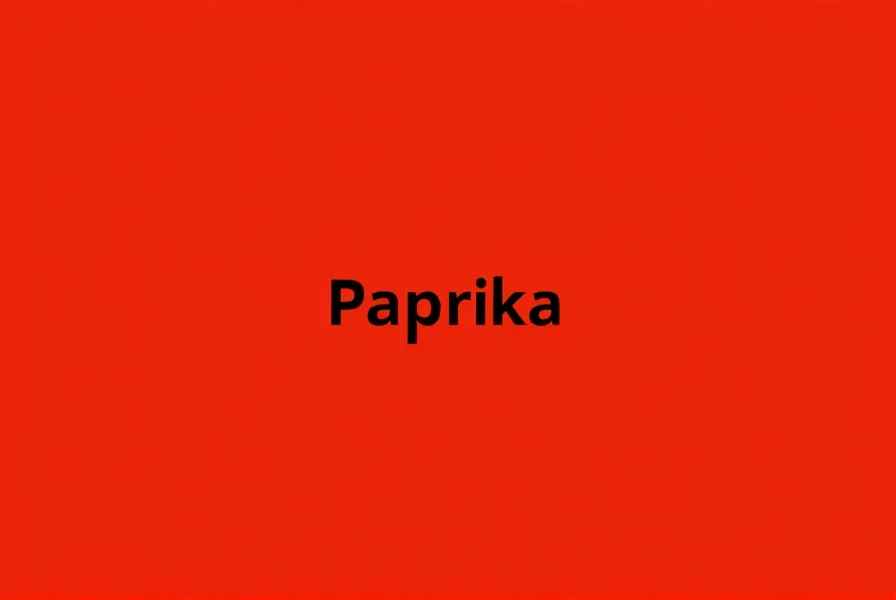Paprika color bridges the gap between culinary tradition and design aesthetics, creating a warm, inviting presence across various applications. Unlike standardized color systems, paprika's visual representation depends on both the spice's origin and how designers interpret its essence. Hungarian sweet paprika typically manifests as a vibrant orange-red, while Spanish smoked paprika (pimentón) translates to a richer, more burgundy-tinged hue in color palettes.
The Origin of Paprika Color Naming
The term "paprika" entered color lexicon through the spice trade, where merchants needed descriptive terms for the vivid red powders arriving from Central America via Hungary. By the 19th century, textile manufacturers adopted "paprika" to describe fabrics dyed with similar red-orange pigments. This cross-pollination between culinary and visual language created a color name that carries cultural and sensory associations beyond mere hue specification.
Color Specifications Across Systems
| Color System | Sweet Paprika | Smoked Paprika | Hot Paprika |
|---|---|---|---|
| HEX | #E44B23 | #C12228 | #D3272C |
| RGB | 228, 75, 35 | 193, 34, 40 | 211, 39, 44 |
| CMYK | 0, 67, 85, 10 | 0, 82, 79, 25 | 0, 81, 79, 17 |
| Pantone | 174 C | 7620 C | 1805 C |
These variations reflect actual differences in paprika spice composition. Sweet paprika made from large, mild peppers creates brighter orange tones, while smoked varieties develop deeper reds through the drying process. Hot paprika's intense red comes from smaller, spicier peppers with higher capsaicin content. Understanding these distinctions helps designers select appropriate paprika shades for specific applications.

Paprika Color in Design Applications
Interior designers increasingly incorporate paprika color as an alternative to traditional reds and oranges. Unlike primary red, which can feel overwhelming, paprika offers warmth without aggression. In living spaces, it works particularly well in north-facing rooms that need visual warmth. Fashion designers use paprika as a autumnal accent that complements both neutrals and jewel tones. The color's versatility stems from its position between red and orange on the color wheel, giving it unique pairing possibilities.
Complementary Color Schemes
When creating palettes with paprika color, consider these effective combinations:
- Earth Tone Harmony: Pair with olive green (#556B2F) and warm beige (#D2B48C) for natural, grounded schemes
- Contrast Approach: Combine with teal (#008080) for high-impact visual contrast that remains harmonious
- Monochromatic: Use varying saturations from pale peach (#FFDAB9) to deep burgundy (#800020)
- Modern Minimalism: Offset with cool gray (#808080) to prevent visual overwhelm
These combinations work across digital and print media. For web design, ensure sufficient contrast between paprika text elements and backgrounds to maintain accessibility. The WCAG 2.1 guidelines recommend a contrast ratio of at least 4.5:1 for normal text, which paprika achieves against light gray (#F5F5F5) but not against white.
Cultural and Psychological Associations
Paprika color carries rich cultural symbolism across different regions. In Hungarian tradition, it represents hospitality and abundance, reflecting the spice's central role in cuisine. Spanish design often associates smoked paprika tones with rustic authenticity and artisanal craftsmanship. From a color psychology perspective, paprika stimulates appetite and conversation, making it popular in dining spaces and social areas. Unlike pure red's urgency or orange's playfulness, paprika strikes a balance between energizing and comforting.
Practical Implementation Tips
When incorporating paprika color into projects, consider these practical guidelines:
- Use 60-30-10 rule: 60% neutral base, 30% paprika as secondary color, 10% accent
- Test physical samples under actual lighting conditions, as paprika shifts dramatically between natural and artificial light
- For digital use, verify color consistency across devices by checking sRGB and CMYK conversions
- Balance intensity with matte finishes in physical applications to prevent visual fatigue
- Consider regional preferences—Central European markets favor brighter paprika tones while Mediterranean regions prefer deeper, smokier versions

Common Misconceptions About Paprika Color
Many confuse paprika color with generic "red-orange" or "burnt orange." True paprika maintains a distinct balance—more red than standard orange but brighter than brick red. Another misconception equates all paprika shades; in reality, the color spectrum varies significantly based on paprika type. Designers sometimes overlook how lighting affects paprika, which can appear orange in daylight but deepen to burgundy under incandescent light. Understanding these nuances prevents implementation errors in both digital and physical applications.
FAQ
What is the exact HEX code for paprika color?
There isn't one exact HEX code as paprika color varies by type. Sweet paprika typically uses #E44B23, smoked paprika #C12228, and hot paprika #D3272C. The most commonly referenced version in design systems is #E44B23, which represents the brighter orange-red characteristic of Hungarian sweet paprika.
How does paprika color differ from burnt orange?
Paprika color contains more red than burnt orange, which leans toward brown. Burnt orange typically has HEX #CC5500 with higher yellow content, while paprika (#E44B23) maintains stronger red undertones. Paprika appears brighter and more vibrant, whereas burnt orange feels more subdued and earthy. In RGB terms, paprika has higher red values (228 vs 204) and lower green values (75 vs 85) than standard burnt orange.
Which colors complement paprika best in interior design?
Paprika pairs beautifully with olive green, warm beige, and deep teal for balanced, inviting spaces. For modern interiors, combine with cool grays (#808080) and cream tones. In traditional settings, pair with mustard yellow and navy blue. Avoid pairing with pure orange or red, which creates visual competition. Earthy neutrals like taupe and warm whites provide excellent backdrops that let paprika shine without overwhelming the space.
Why does paprika color vary between different design systems?
Variations occur because paprika references a natural product with inherent color differences. Sweet Hungarian paprika produces brighter orange-red tones, while Spanish smoked paprika yields deeper, more burgundy shades. Design systems standardize based on regional preferences and intended applications—fashion palettes often use brighter versions, while interior design systems favor more muted tones. Additionally, color reproduction limitations across digital and print media contribute to these variations.
How can I ensure accessibility when using paprika color in web design?
For text elements, maintain a contrast ratio of at least 4.5:1 against background colors. Paprika (#E44B23) achieves this against light gray (#F5F5F5) but not pure white. Use tools like WebAIM's Contrast Checker to verify. For data visualizations, pair paprika with distinct patterns in addition to color. Avoid using paprika alone to convey critical information—always provide text labels or patterns. When used as an accent color rather than primary text color, paprika generally meets accessibility standards when properly contrasted with neutral backgrounds.











 浙公网安备
33010002000092号
浙公网安备
33010002000092号 浙B2-20120091-4
浙B2-20120091-4